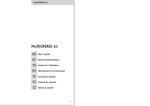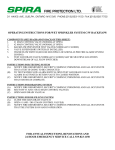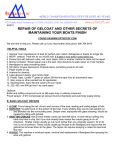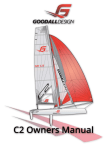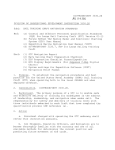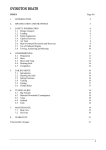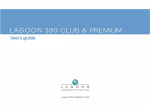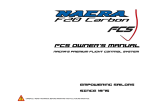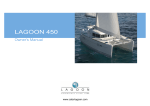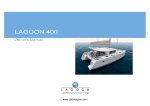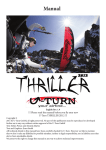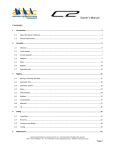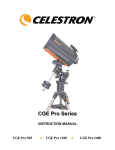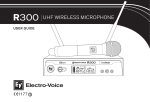Download Optimist Owners Manual - McLaughlin Boat Works
Transcript
1 THANK YOU for buying a McLaughlin Optimist Dinghy. We know that it will more than exceed your expectations. McLaughlin stands behind its products 100%. Please call your dealer or us if you have any problems or even if you just have a good story to tell. (800 784 6478, 800ptimist or for international call 423 875 0740). Remember our web site is packed with technical data on rigging and tuning plus there is an online parts locator. (www.optistuff.com) An Optimist is more than a sailboat. It is a platform from which to build self-confidence, self-esteem, sportsmanship, honesty & social skills. We at McLaughlin hope that this boat brings you hours of fun & enjoyment. ****************************************************************************************** NEW OWNERS REGISTRATION VERY IMPORTANT McLaughlin has paid for a one-year membership in USODA and a free subscription to Optinews. - The best youth sailing publication in circulation. This applies only to new USODA members who live in the US. To make this all happen McLaughlin needs the following data: Boat Number USA E-Mail Address (adult) Skipper’s Name (1 only) Your Name Home Address _____________ISAF No_________________ _____________________________________ ____________________Birth Date ________ _____________________________________ ___________________________________________ _____________________________________ Yacht Club Name __________________________ (To Be Filled In By McLaughlin: Date Boat Built _________Date Measured________) USODA will contact you with a user name and pass word allowing you to check your data and request free membership on line at www.usoda.org or Phone 609 492 9000. The boat certificate can be printed from the USODA web site. Membership cards are no longer given out or required. Regatta personnel checking membership with USODA do this online. Incidentally no one can open your data file but you and the USODA office. PLEASE: Fax, mail or email this page To McLaughlin at 423-875-4011, e-mail to [email protected] Form: Optimist owners manual 8/13/03 McLaughlin Optimist Owners Manual 2 If you have a problem contact your dealer or McLaughlin: www.optistuff.com 800 784 6478 (423 875 0740) (1) Parts of the Optimist McLaughlin Rigging Instructions Getting Started. 1. These instructions are written specifically for the McLaughlin Club Racer and Trainer. Racing models, including the Intermediate Racer, Advanced Racer, and Pro have supplemental rigging instructions, a copy of which is included in this manual after the “Tie on the sail section”. 2. Unpack your new McLaughlin Optimist and spread out the parts on a clean, dry section of grass. Take a moment to look over the parts list and familiarize your self with the major parts. (See illustration (1)). Be careful not to loose or throw away small parts such as tiller screws. 3 PARTS LIST Owners Manual Hull Spar Set with mast, boom and sprit (Racing Spars include a B-Pack with wind pennant, and sprit halyard, plus pre-rigged vang, bridle and outhaul) Carbo Boom Block: safety snap shackle attached Sail with 2 battens 3 Air Bags Bailing Bucket: tie to forward air bag strap Bow line: 28 foot ¼ inch yellow floating line Rudder and Tiller/Hiking Stick Centerboard with Tie in line Main Sheet: 21 foot 5/16 black floating line Note: On racing spars many of these lines will already be attach for you. The colors will also be different. Line Packed in a zip lock bag: (Club Racer only) (1) 3/16 x 40 in. red Boom Vang (1) 3/16 x 58 in. blue Lower Sprit Line (1) 3/16 x 40 in. red Out Haul (1) 3/16 x 40 in. blue Upper Sprit Line (14) 2 mm x 17 in. black Sail Ties: (5) 3 mm x 22 in. black Corner Ties (1) Harken Micro Block (1) 3 mm x 22 in. black Preventer (1) 3 mm x 60 in. black low stretch Boom Bridle with attachment Ring. See your packing list or sales receipt for non-standard items such as: Racing Sails, Praddles, Top and Bottom Covers, Blade Bag, Spar bag or Dolly. Note racing sails come with sail ties in the sail bag. They are not included with the boat. Required Tools: 1. Flat Head Screw Driver 2. Small Adjustable Wrench or Pliers 3. 5/32-inch drill for aliening tiller holes with the blade holes if needed. Install your air bags. 1. Slide your un-inflated air bags into the straps on each side and in the stern of the hull. The bags can be inflated manually or with a low-pressure air pump or compressor. 2. Note: Do not over inflate the air bags! When properly filled, the air bags will be soft to the touch. Over inflated bags may burst when heated by the sun or rising temperatures. Layout the mast and boom on the ground. 1. The Mast and Boom form an "L" shape, with the jaws of the boom fitting tightly around the mast about halfway between the two mast cleats. Refer to illustration (1) 2. Note that the eye straps on the top of the mast should be opposite the boom, as is the white Preventer Button. Also note that the lip on the end of the boom and the buttons toward the middle of the boom should be facing up. 4 Tie On The Sail (2) Parts of the Sail (3a) Head (3b) Tack 1. Lay the Sail in place and remove the two bundles of thin black line from the line pack. 2. Start with the Corner Ties. (The bundle of 6, 3 mm 22 in. black lines) Each corner tie should be passed through a sail grommet and around the spar twice, for extra strength. Illustrations (2) and (3) will help you identify the parts of the sail and how they are tied. The extra corner tie is your boom Preventer. 3. Tie the Head of the sail first. Start by lining up the topsail grommet and the topmast eye. Tie around the entire mast passing through the topsail grommet and the top eye strap. Next, tie the second corner tie from the topsail grommet through the lower eye strap. This tie should prevent the sail from rising up when the sprit halyard is tensioned and also keep the first corner tie from slipping over the top of the mast. (See illustration (3a)) 4. Tie the Tack next. The tack uses two corner ties, one to secure it to the mast and one to secure it to the boom. (See illustration (3b)) 5. Tie the Clew last. A common mistake is tying the clew directly to the lip on the end of the boom, this is incorrect. The clew should be tied around the boom so that it slides freely. 6. The 6th corner tie is used for the Boom Preventer. (See illustration (3b)) The boom Preventer is a sling that rests on the mast's Boom Preventer Button. Its purpose is to control the height of the boom by twisting (not shown) the line to effectively shorten it, and therefore prevent the boom from dropping as the mainsheet and vang are tensioned. This prevents over tightening of the luff and leach of the sail (which is slow in most conditions.) To rig the boom preventer, tie a stopper knot in one end of the corner tie. Next, thread the free end of the corner tie through one of the holes in the boom jaw (from the bottom to the top), loop over the Preventer button on the mast, and through the other boom jaw hole. Now secure it with a stopper knot in the free end of the corner tie. 7. Now that the corners are ready, use the Sail Ties (bundle of 14 thin purple lines) to finish tying the sail. The ties along the mast should be tight, with no more than 1/8 in. between the sail and the mast. The ties along the boom should have a space of about 1/4 in. between the sail and the boom. 5 Special Instructions For A Removable Racing Sail (Applies to the Silver and Black Gold spar sets) Read this along with the information shown above. Race sails are very expensive and wrinkle easily. Heavy creasing of the sail changes its shape and therefore its performance. With the club spars you normally wrap the sail around the mast and boom causing creasing. To remove the sail and roll it requires you to untie every sail tie on the mast. Not a fun job. That is why the racing spars were developed. So that you can slide the sail off the mast without untying the sail ties. All the upper fittings on the mast are removable to accommodate this. You then loosely wrap the sail around just the boom. Even the battens fall into place parallel to the boom. The boom prevents the sail from getting folded in two and acts as a mandrel to roll against. This keeps the sail looking good throughout its life. Tying on you race sail 1. Layout your mast and boom (make sure the boom is right side up and the boom preventer line is around the mast). 2. Layout the sail and begin at the top. Use a 3mm x 22” corner tie, wrapping twice around the mast at the upper front mast hole and twice through the throat grommet (yeah, that’s the big top one in the corner) of the sail. 3. Tie it tightly so the edge of the sail is touching the mast. Use a square knot (sometimes called a reef knot) at this point. 4. Next, insert your wind pennant at an angle into the mast end and snag just one of the wraps of the tie through the top hole with the point, or use the top pins. 5. As you continue to push the needle of the wind pennant, notice the tie getting tighter. At this point you may need to loosen the upper part of the knot just slightly (especially on a light wind day). With the needle in position, the corner tie should be taut, with the sail firmly against the backside of the mast. You have used the leverage of the needle to tighten the tie and in the process; the knot has been drawn tighter. 6. Now pull hard on each end of the corner tie line to secure the knot. Then add half a square not, as a “keeper” on top of the existing square knot. The keeper does two things. It keeps the knot tight and acts as a safety net. If the second knot comes undone you still have the fist knot. There are several other ways to accomplish this, but none as efficient. Note: If you cross the finish line with an untied or missing sail tie you can be disqualified. Not keeping the sail mark between the two bands on the mast is also a violation of the rules. These two rules are checked closely at major regattas. That is why knot tying is so important. 7. If you followed directions, the sail mark should be in the middle between the mast bands. Now to keep the sail mark between the bands you need to add the halyard Preventer corner tie. This tie prevents the sail from rising upward as the sprit pulls the top of the sail upward to obtain its proper shape as you tension the sprit halyard. See Paragraph 3 and diagram 3a in the previous section “Tie the head first”. 8. Use the top pin or push the sail tie into the second hole from the top as shown in the diagrams following this section. Insert the flag pennant needle into the loop or top pin. Continue to push it in until it hits the flotation cork about 6 inches down from the top. Then wrap the Preventer corner tie around the mast and through the same grommet as the top corner tie and secure it with a square knot. Again look at diagram 3a. 9. Check the position of the sail mark in relation ship to the mast bands by pulling up ward on the top of the sail to simulate the upward pressure of the sprit halyard tensioner. Adjust your sail tie so the sail mark is on the high side toward the top band. This seems contrary to your thinking but once you put on the boom vang and boom Preventer the sail mark will move downward hopefully to a half way point. Now add a second square knot as a keeper like you did on the first corner tie. 10. Now tie on the sail ties as described in paragraph 7 “Sail Ties” of the previous section. 6 7 Rig your boom bridle. 1. Locate the two Boom Bridle Buttons on the topside of the boom; each is about midway to center on either end. Attach the Boom Bridle (3 mm, 64 in. black low stretch line with an attachment ring on it) to the boom by tying around the boom on the outside of each button. (See illustration (4)). This line must be very tight. See safety notes as to why! (4) Outhaul and Bridle Rig your control lines. 1. Locate the Boom Vang Button near the jaw end of the boom. Use the Vang line (3/16, 30 in. Red line) to tie around the boom so that the button prevents the line from sliding toward the mast. Then tread the line through the vang cleat on the mast, from the bottom to the top. 2. Now rig your Outhaul. Tie a stopper knot in the end of the line. From the back of the boom, thread the line through the hole in the lip of the boom end, through the sail grommet, then back out the hole in the boom end. Now run the line through the cleat located on the side of the boom. 3. The next sail control is the Sprit Halyard. Locate the Sprit Halyard Block on the front side of the mast. Run the Upper Sprit Line (3/16, 40 in. blue) through it and tie a small bowline (loop) in one end. To the other end, tie the Micro Block provided with your line pack. Now locate the Lower Sprit Line (3/16, 58 in. blue line) and tie one end to the bridge of the Sprit Halyard Cleat. Next, run the free end of the lower sprit line through the Micro block and through the sprit halyard cleat. (See illustration (6)) (5) Boom Vang (6) Sprit Halyard Stepping the mast. 1. Point the bow of the boat into the wind. 2. Pick up your rig and put the mast through the hole in the thwart (deck) and into the Mast Step. (See illustration (1)) 8 3. Raise the Sprit by placing the tip of the upper end (the end w/o the plastic chafe guard) into the loop at the peak of the sail. Place the lower end into the loop you tied into the upper sprit line and adjust the tension at the sprit halyard cleat. Remember that the sprit is always rigged on the starboard (right) side of the mast. Rig the Main Sheet and Mast Tie down. Start by securing the Boom Block to the boom bridle with the trigger snap. The trigger snap is your quick release system for the sail. Tie one end of the Main Sheet (21 foot 5/16 black line) through bottom hole of the block with a bowline or stopper knot. Run the free end through the small hull block from back to front, through the boom block from front to back and through the large ratchet block. (See illustration (7)) Make sure that the ratchet block "clicks" when the main sheet is tightened and locks when the main sheet is released. If you prefer to turn off the ratchet, you can do so by adjusting the slide on the side of the block. Tie a stopper knot in the loose end of the main sheet. Secure the Mast Tie Down! This is the most important line on the boat. It is already properly installed on the deck in front of the mast hole. To secure the Mast Tie Down, tie around the mast and over the vang cleat. The line is long enough to go across the cleat and around to the front of the mast where it can be tied and not obstruct the cleat from turning side to side. It is very important that this line is always tied, and tied tightly. (See illustration (8)) Failure to secure this line will result in a dismasting during capsize and can seriously damage your Optimist. (7) Main Sheet (8) Mast Tie Down VERY VERY IMPORTANT Assemble the rudder. Remove the Tiller, Rudder and Dagger board from its protective packaging. Don't throw away the packaging until you've accounted for all three, plus the 2 sets of tiller bolts, nuts and washers. Place the rudder head between the bars of the tiller. Check to see that tiller is facing the same direction as the rudder pintles and that the Tiller Extension is facing up. Secure the tiller with the tiller bolts through the predrilled holes. (It is usually easier to start with the rear bolt). If the holes do not exactly line up it maybe necessary to reem the front hole with a 5/32-inch drill. Finishing Up. 1. The Bow Line (28 foot 3/16 yellow line) should be led through the bow loop and then down to the mast step. Go around the mast cup with a tight bowline knot. When towing make sure the line does not get 2. 3. 4. 5. caught under the screw sticking out the back. If this happens it can cause serious damage to 9 the function of the screw and knob. Tie the Dagger board to the eye strap on the forward face of the dagger board trunk. Blunt end forward. Before launching your new McLaughlin Optimist, check the launching area for anything that might damage your boat. (rocks, shells or debris) Once the boat has been launched and is in sufficiently deep water, secure the rudder by placing the rudder pintles into the stern gudgeons. The rudder will automatically lock into place with the metal keeper tab. (To remove the rudder, press the keeper tab and lift it from the gudgeons). Next, slide the dagger board into the dagger board trunk and tie the keeper line to the eye on the trunk. Be sure the blunt end of your dagger board is facing forward. If your life jacket is on and zipped up, you're ready to go sailing! Safety Tips Although sailing is a relatively safe sport, the sea ensures that there is always risk of accident. The following is a brief list of precautions that will greatly reduce the risk of serious injury. 1. Always wear a US Coast Guard Approved PFD. Not only is it a class rule but life jackets save lives everyday. Make sure that yours fits properly and is rated for your weight. Too many Optimist sailors hit the water with a PFD that is far too big for them. Only a properly fitted and properly worn life jacket can save your life. 2. It is an IODA (International Optimist Dinghy Association) class rule that the boom bridle never extends more than 10 cm from the boom. This rule was created, and should be heeded, because it greatly reduces the risk of a sailor's head being caught in the bridle during a maneuver. Keep your bridle tight! 3. The trigger snap provided with your boat is designed to prevent catching on clothing, don't replace it with shackles that can. If your trigger snap wears out, contact your dealer or McLaughlin Boat Works to purchase a replacement. 4. Attend a sailing course taught by US Sailing certified instructors and never send a child sailing without adult supervision. 5. Always check the weather before going sailing. Checking weather conditions and knowing your limitations is an import part of safe sailing. 6. Wear appropriate clothing. Since you've already checked the weather (see #5), you know what to expect in terms of temperature and precipitation. What is merely uncomfortable for some athletes can be dangerous for sailors. Your mental ability is what you require most while sailing, and that's what hypothermia takes first. Remember, there's no such thing as over prepared for a sailor, and you can't just "run to the sidelines" for a sweater if you get cold. 7. Wear sunscreen. While sailing, you'll get a double dose of sun, once from the sun, once from the water reflection. There's nowhere to seek shade, so bring your own. (Hats, loose cotton clothing, etc.) 8. Stay hydrated. Sailing is primarily a summer sport, which means lots of sun and lots of heat. Always bring water with you and drink even when you're not thirsty. Care and Upkeep 10 Storage: 1. A good set of covers and a dolly will pay for themselves in resale value the first year you own your boat. Especially in the Optimist class, with all the travel and handling your hull will endure, protection needs to be your first priority. Covers, a dolly, and especially a blade bag, are a must if you want to keep your boat looking and performing at its best. The blade bag is the first cover to buy. It provides a breathable compartment to store the skippers life jacket, gloves, sun screen, sunglasses, money, set of dry clothes, just about anything they can misplace or loose. These items make great birthday and Christmas gifts. 2. Don't store your foils in an exceptionally hot environment. (For example, a car's trunk in summer) 3. There are many options for day-to-day storage. Most commonly, the hull is stored upside down in its bottom cover, or right side up on a dolly with a tented top cover. These items are available through your dealer. 4. If possible, your Optimist should be stored indoors for the winter. If that is not possible, it should be stored upside down; in it's cover, on padded racks. Do NOT shrink-wrap your Optimist. 5. It is best to store your Optimist upside down, resting on the deck. If you chose to store your boat upright, make sure the bottom is evenly supported and never place anything in or on the boat. Transportation: 1. The Optimist is easily car topped or trailed. Trailers are available in all shapes and sizes, ranging from small 2 boat trailers to huge 20 and 30 boat trailers. If you are only transporting 1 boat, we highly recommend car topping over trailing. 2. When transporting your Optimist on a trailer/car, always use padded bunks and secure the boat deck down. Never travel with the hull resting on its bottom. 3. When transporting your Optimist, either use a top cover or remove the air bags from their straps. The constant pressure of the wind will damage air bags if left unprotected in the boat. 4. Utilize safety lines. Tie a line between the primary straps and cinch it tight, its purpose is keep the straps from sliding apart and off the boat. Tie from a secure point on boat (hiking straps, main sheet block, mast step) directly to the trailer or roof rack. This line will assure that, even if the straps are lost, the boat cannot be completely lost. Care and Cleaning: 1. 2. 3. 4. When sailing in salt water, thoroughly rinse the entire boat with fresh water, including sails and spars. Always allow sails to dry before stowing. Sailcloth, like most fabrics, will mildew if stored wet. Store the dagger board and rudder in a cool place, excessive heat can cause warping and blistering. There are many high quality marine-cleansing products on the market. Avoid any cleaner, which includes abrasives. For daily cleaning, we recommend non-toxic, biodegradable soaps such as Lemon Joy dish detergent. 5. For more serious stains, we recommend Starbright Boat Cleaner. This is a more chemically active cleaner and should only be used after soap and water has been tried. 6. Very serious stains can be removed from gel coat using lacquer thinner. Lacquer thinner will dissolve stickers, so be careful where you use it. Left on the surface it will eventually dissolve gel coat as well so, be sure to thoroughly rinse with water afterwards. An adult should supervise the use of lacquer thinner. 7. Wet sanding is required only if the bottom is scratched. Your McLaughlin Optimist arrives with a race ready finish. Cleansing the bottom with soap and water to remove dirt and oil is the best pre-race preparation. Basic Tuning 11 Mainsheet- Mainsheet controls boom position; it is a balance between pointing and speed. Upwind, the sail should be trimmed to the leeward comer of the transom for most conditions, further in for heavy air, further out for light. It is usually better to give up maximum pointing for increased speed. Luff Telltales- In light wind, out of tacks or while footing for speed, steer so that the luff telltales are flying straight back. In medium wind with flat water or light chop, steer so that the windward telltale is partially stalled, and the leeward telltale is flying straight back. In heavy wind (when you can no longer hike the boat perfectly flat), steer so that the windward and leeward telltales are somewhat stalled. A luff should only be carried when feathering in very heavy winds. Before carrying a luff, you should consider raising your centerboard slightly to de-power the boat. Leach Telltales- Because of the limited control the vang offers on an Optimist, the leach telltale is mostly an indicator of mainsheet trim. Generally, it should be steaming straight back with the curvature of the leach. If it is stalling to windward, you are under trimmed. (The luff telltales will almost always be a better indicator of this) If the leach telltale is stalled far to leeward, you are either carrying too much vang or are over trimmed, either way the leach is stalled. Boom Preventer - The boom Preventer controls the luff tension in conjunction with the vang and sprit. In medium winds the luff should have "neutral" tension under pressure, no horizontal wrinkles or vertical wrinkles. In light winds, one or two twists should be added to produce very slight scallops under pressure. In heavy winds, twists should be let off to produce a vertical wrinkle in the luff, however, that wrinkle should disappear under pressure. Vang - The vang controls the luff tension upwind and leech tension off the wind. Use these settings as a starting place. 5 knots: Use the Mainsheet to trim for your upwind boom position, and then cleat the vang at that spot. If the wind is puffy, trim for the median wind speed but leave a small slack in the vang. This will give you added leach control upwind 8 to 12 knots: Trim until the boom is centerline and 5 to 8 inches off the transom, and then cleat the vang. In puffy conditions, trim for the median wind speed or slightly less. 15+ knots: Trim until the boom is 0-3 inches from the transom, and then cleat the vang. If the leach is stalling, ease the vang slightly or loosen the clue tie. Outhaul- In medium air, the outhaul should be trimmed with pronounced scallops along the foot. The clue should be 3-6 cm from the end of the boom. In heavy air the outhaul should be tightened so that the scallops are removed. However, it should never be so tight that a hard crease in the foot is induced. In light air it should be eased to a maximum of about 7 or 8 cm from the end of boom. Sprit- When rigging, slight wrinkles should appear from the sail's peak to the tack. In light wind these wrinkles should be very small, in heavy wind the sprit should be tightened so that the wrinkles become pronounced. In any wind speed, the sail should be perfectly smooth at the median or predominant wind speed on any leg of the course. As a result, slight wrinkles will sometimes appear from the top of the mast to the clue in puffs and from the peak to the tack in lulls. In medium and strong winds, especially with light sailors, err to the side of wrinkles from the top of the mast to the clue, as this will open the leach, rather than stall it. Generally, it is better to lose pointing and gain speed by opening the leach rather than losing both pointing and speed by stalling the leach. 12 Mast Rake- Mast Rake is a highly personal measurement, which effects power and pointing. The following table should be used as a starting point for your rake. From that starting point you should adjust the rake to suit your personal sailing style (are you a "footer" or a "pointer"?), the wind conditions you will be sailing in, the sea conditions and your spars (are they stiff or bendy?). Generally, your rake should be adjusted so that the boom is parallel with the water when sheeted for optimum upwind sailing. The following measurements are taken from the top of the mast to the rear deck bottom lip. Childs Weight (lbs.) Mast Rake (in) Under 70 109-110 70-80 110-111 80-90 111-112 90-100 112-112.5 100-110 112.5-113 110-120 113-113.5 Over 120 114-114.5












